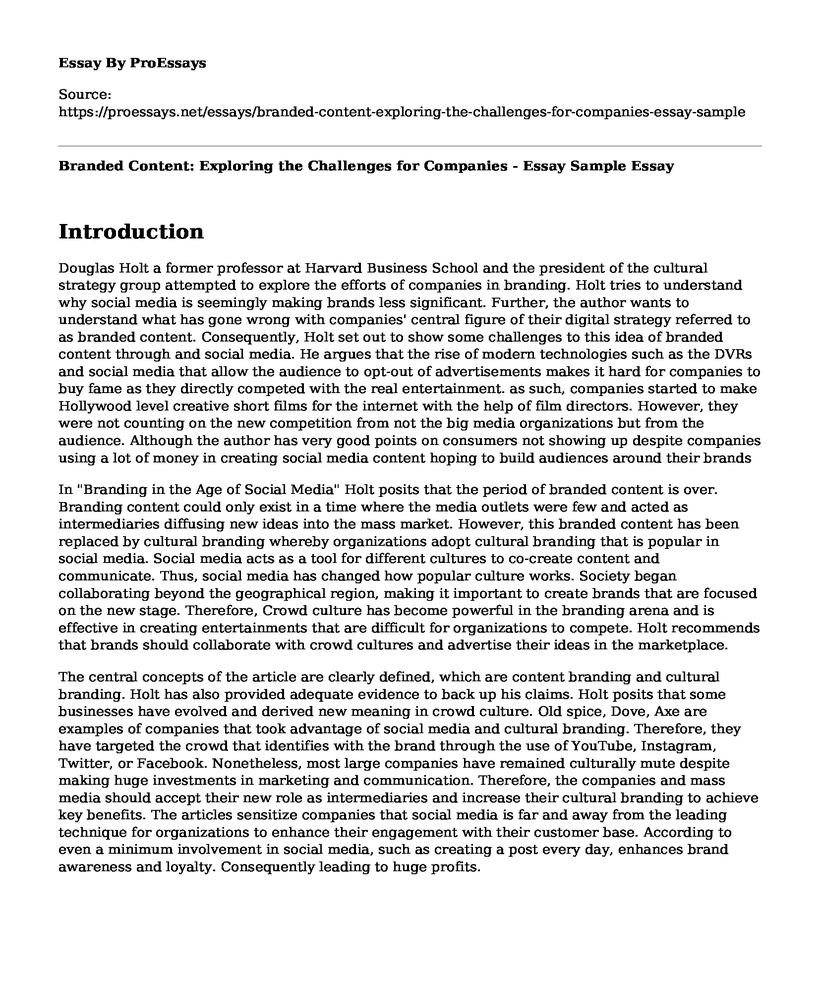Introduction
Douglas Holt a former professor at Harvard Business School and the president of the cultural strategy group attempted to explore the efforts of companies in branding. Holt tries to understand why social media is seemingly making brands less significant. Further, the author wants to understand what has gone wrong with companies' central figure of their digital strategy referred to as branded content. Consequently, Holt set out to show some challenges to this idea of branded content through and social media. He argues that the rise of modern technologies such as the DVRs and social media that allow the audience to opt-out of advertisements makes it hard for companies to buy fame as they directly competed with the real entertainment. as such, companies started to make Hollywood level creative short films for the internet with the help of film directors. However, they were not counting on the new competition from not the big media organizations but from the audience. Although the author has very good points on consumers not showing up despite companies using a lot of money in creating social media content hoping to build audiences around their brands
In "Branding in the Age of Social Media" Holt posits that the period of branded content is over. Branding content could only exist in a time where the media outlets were few and acted as intermediaries diffusing new ideas into the mass market. However, this branded content has been replaced by cultural branding whereby organizations adopt cultural branding that is popular in social media. Social media acts as a tool for different cultures to co-create content and communicate. Thus, social media has changed how popular culture works. Society began collaborating beyond the geographical region, making it important to create brands that are focused on the new stage. Therefore, Crowd culture has become powerful in the branding arena and is effective in creating entertainments that are difficult for organizations to compete. Holt recommends that brands should collaborate with crowd cultures and advertise their ideas in the marketplace.
The central concepts of the article are clearly defined, which are content branding and cultural branding. Holt has also provided adequate evidence to back up his claims. Holt posits that some businesses have evolved and derived new meaning in crowd culture. Old spice, Dove, Axe are examples of companies that took advantage of social media and cultural branding. Therefore, they have targeted the crowd that identifies with the brand through the use of YouTube, Instagram, Twitter, or Facebook. Nonetheless, most large companies have remained culturally mute despite making huge investments in marketing and communication. Therefore, the companies and mass media should accept their new role as intermediaries and increase their cultural branding to achieve key benefits. The articles sensitize companies that social media is far and away from the leading technique for organizations to enhance their engagement with their customer base. According to even a minimum involvement in social media, such as creating a post every day, enhances brand awareness and loyalty. Consequently leading to huge profits.
Conclusion
In conclusion, Holt's articles posit that companies need to embrace cultural branding to sell their brands. According to Kohli, Suri, and Kapoor, (2015), a brand is defined by the people who use them, interact and talks about it. Thus, this explains the shift set out by Holt from a branding content to cultural branding. Therefore, I concur with Holt that brands do not define people who use them, rather, they are defined by people who use them. As such, social media permits brands to capitalize upon this, as it allows more of these talks to go on and this information reach more people. Besides, brands can facilitate and join in these conversations. Hence, online communities are imperative and they allow companies brands to engage with their clients in a manner that the customers have always wanted.
References
Holt, D., 2016. Branding in the age of social media. Harvard business review, 94(3), pp.40-50.
Kohli, C., Suri, R. and Kapoor, A., 2015. Will social media kill branding?. Business Horizons, 58(1), pp.35-44. Kohli, Suri, and Kapoor, (2015)
Cite this page
Branded Content: Exploring the Challenges for Companies - Essay Sample. (2023, Apr 04). Retrieved from https://proessays.net/essays/branded-content-exploring-the-challenges-for-companies-essay-sample
If you are the original author of this essay and no longer wish to have it published on the ProEssays website, please click below to request its removal:
- Research Paper on Microsoft Corporation: Organizational Restructuring
- World Without Mind by Franklin Foer Essay Example
- Strategic Management Paper Example: Case Study Analysis on Amazon
- The Most Advanced/Interesting Computer Application - Essay Sample
- Essay Example on Amazon: Earth's Most Customer-Centric Organization
- Essay Example on Amazon: World's Second-Largest Company, $900 Billion Revenue
- Free Essay Sample on Project Managers







